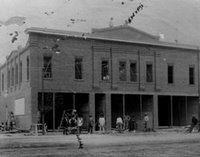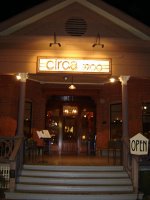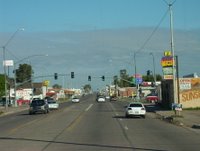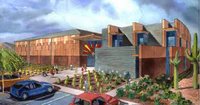 [Source: Dan Sorenson, Arizona Daily Star]
[Source: Dan Sorenson, Arizona Daily Star] -- Tombstone's historic credibility is either gut shot or better than ever, depending on which of the town's many historians you're asking. Meanwhile, City Hall is crumbling and full of bees, bats and mold, and the mayor says he's willing to name it after Wal-Mart, Costco, Bill Gates or anyone who would give him the money to fix it up. The credibility problem — the National Park Service declared Tombstone's National Historic Landmark status "threatened" nearly three years ago — concerns Mayor Andree DeJournett, although it doesn't have the immediacy of the crumbling walls, bees, bats and mold. He says the town has a grant writer who is working on finding money for the tough town's crumbling past and present. "This place needs millions of dollars," he says. "We need money for all the buildings here. We probably got $250,000 to $300,000 (in grants) this year."
But while the City Council needs a safe place to meet — free of 1880s-era crumbling walls and modern bees, bats and mold — and the police and fire departments need new radios, the mayor also knows the importance of the city's historical status. "Tourism," DeJournett says, "that's all we have here." And tourism's economic clout is easily quantified, in some cases. DeJournett says visitor donations alone at the city-run Boot Hill Graveyard (& Gift Shop) topped $115,000 for the most recent year. Every year, he says, roughly 600,000 people visit Tombstone. Meanwhile, there's a ballot question in the November election that asks voters if they want the city to continue operating the famous boneyard or turn it back over to a contractor — the way it was for many years.
DeJournett says he's for keeping it under city control. He figures there's no way the town will make as much money off the property by leasing it out as by running it. He also supports a proposed ordinance that would declare Boot Hill a historic district, making it hard for anyone — including a possible future Boot Hill concession operator — to do anything to damage the graveyard's historic credibility. Things are bad enough already, says Bill Pakinkis, a retired Marine and amateur history buff who sits on the council's historic districts commission. He's a major force behind the historic district proposal. "People feel cheated when they come in here," Pakinkis says. "It looks like everyone was buried the same day," Pakinkis says, referring to the nearly identical beige-painted metal grave markers.
[Note: To read the full article, click here.]
 [Source: Nicole Fuggs, Arizona State University State Press Magazine] -- Mill Avenue isn't just a spot for shoppers or a nightlife nexus. It's a little slice of Arizona's history. So sit back and let SPM school you on this blast from the past. Urban Outfitters, Starbucks and Hippie Gipsy by day. Hooters, the Library and the Big Bang by night. These are several of the iconic locations that draw students to Mill Avenue. But contrary to popular belief, it wasn't always the brew that brought visitors to this mecca of activity.
[Source: Nicole Fuggs, Arizona State University State Press Magazine] -- Mill Avenue isn't just a spot for shoppers or a nightlife nexus. It's a little slice of Arizona's history. So sit back and let SPM school you on this blast from the past. Urban Outfitters, Starbucks and Hippie Gipsy by day. Hooters, the Library and the Big Bang by night. These are several of the iconic locations that draw students to Mill Avenue. But contrary to popular belief, it wasn't always the brew that brought visitors to this mecca of activity.







